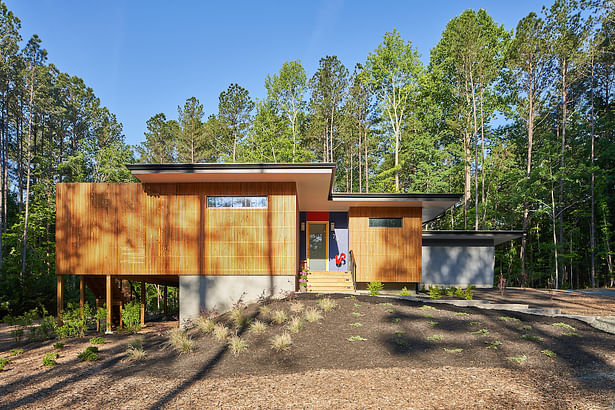
Chapel Hill, NC

A married couple whose grown son comes for visits occasionally were determined to "break free" (their words) from the traditional, "soul-deadening" (ditto) residential development where they lived.
Modernists at heart, they longed for a quiet, secluded place in the woods where they could build a simple, modern, unpretentious, age-in-place, environmentally sustainable house custom-designed for their lifestyle, their needs and dreams, and their passion for privacy.
“We want a house just for the two of us,” they said. “We don't want to socialize. We want to be left alone to enjoy our life.”
After they found the perfect hideaway site in a forest in Chatham County, North Carolina, they turned to Chapel Hill, NC-based architect Arielle Condoret Schechter, AIA, to help them realize their dream. They knew her reputation for designing precisely the kind of house they imagined. They also knew she could make their dream home Net Zero so that it would produce, by renewable methods, as much energy as it uses. They intended to age in place without energy bills.
They had one more specific request for their new home: "a sheltered place to sit outside and watch the rain."
The concept for this house-for-two (plus an extra bedroom for their son when he visits) involved a "screened" facade towards the approaching road. The windows on this side are high so that no one can peer inside. The natural cypress screen filters light, obscures the view of the owners’ large, private deck, and complements the natural setting.
Beyond the screen, the house bursts forth into the light with abundant glazing and bright blocks of primary colors. This side is only for the couple and their guests. It's a joyous place full of light inside and a broad deck outside for grilling, dining, and relaxing.
The blocks of primary colors are architectural elements, inspired by the Netherlands-based De Stijl movement of the early 1900s. De Stilj devotees believed that harmony and order could only be established by reducing elements to pure geometric form and primary colors.
That concept seemed fitting for this house. The simple form, elevated where necessary to accommodate the natural contours of the land, is composed of three rectilinear volumes. Each clear volume is defined by its individual flat roof. Roof overhangs around the entire house shade the windows that provide a constant visual connection with the natural setting.
At the central volume, oversized glass doors open onto the deck. Overhead, a large, deeply cantilevered roof reaches out to the south not only to shade walls of glass there but also to provide the sheltered outdoor space where the couple can "sit outside and watch the rain."
Schechter oriented the house on its site to maximize solar gain, natural light, and natural ventilation (the latter when weather permits). She supported the “low tech” principle of orientation and roof overhangs with such high-tech features as:
All of these elements ensure that the house achieves Net Zero performance.
The clean, crisp interior features zero thresholds, curb-free showers, and oversized doorways -- aging-in-place principles the homeowners will enjoy for years to come.
Status: Built
Location: Pittsboro, NC, US
Firm Role: Architect
Additional Credits: General Contractor: Newphire Building, Chapel Hill, NC
Photography: Keith Isaacs, Raleigh, NC